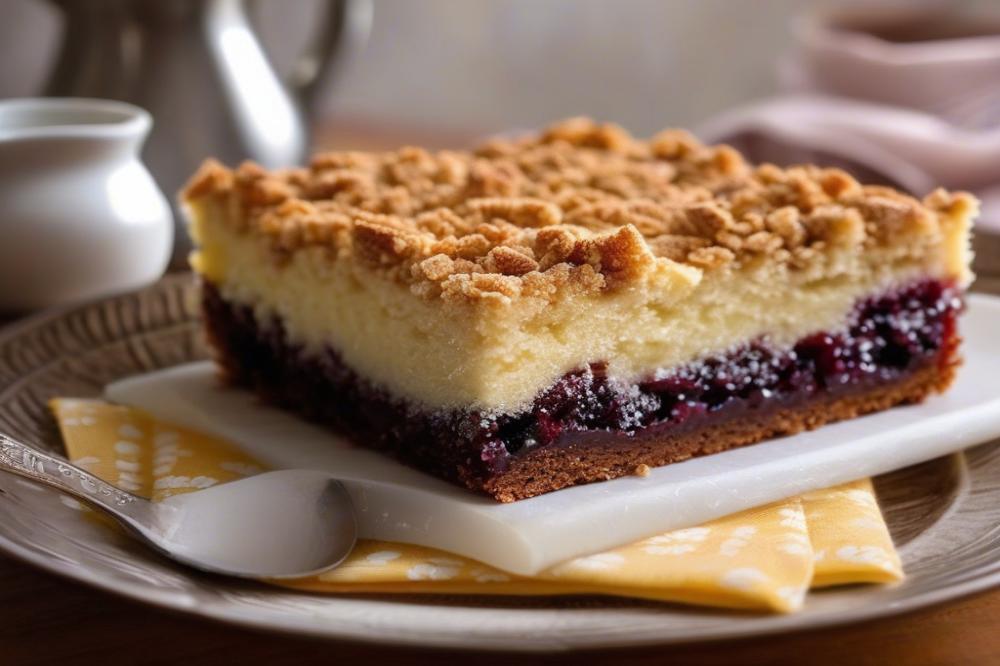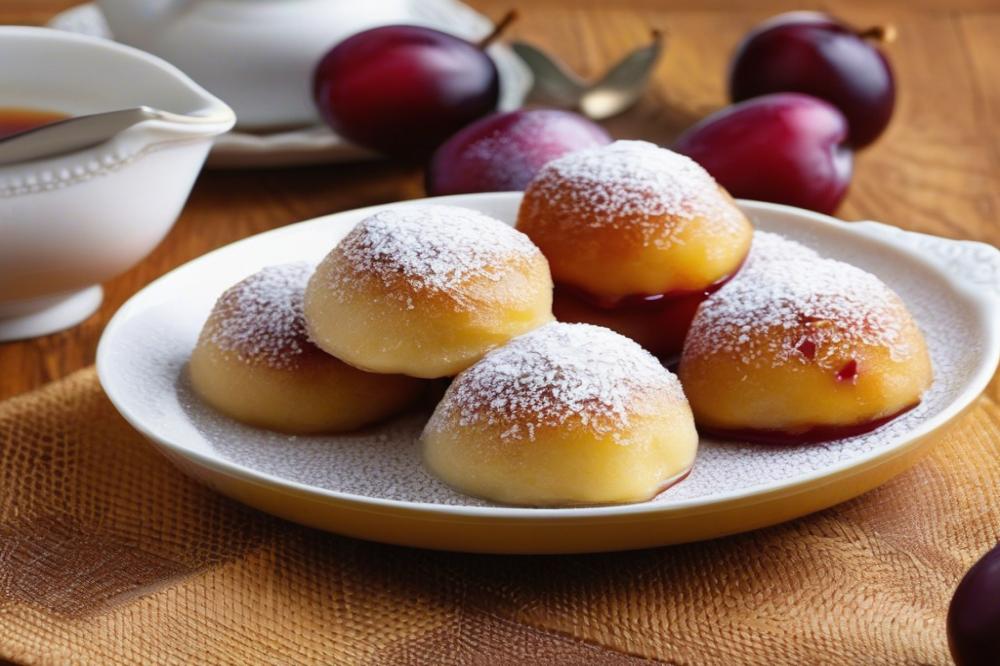Ciasto Drożdżowe: A Staple in Polish Culture
Ciasto Drożdżowe is more than just a dessert; it holds a special place in Polish culture. This beloved Polish Yeast Cake combines the rich flavors of sweet bread with the crisp texture of a streusel topping. Families often serve this treat during festive occasions, making it a symbol of togetherness. Every bite offers a taste of heritage, connecting generations through the joy of baking.
For many, enjoying Ciasto Drożdżowe is a cherished tradition. It is not unusual to find this recipe passed down through families, becoming a staple at gatherings. The dough rises beautifully, creating a fluffy texture suitable for any time of day. Whether served as a coffee cake or with a fruit topping, its versatility makes it a preferred choice among many dessert lovers.
This traditional recipe reflects the heart of Polish home cooking. Easy baking techniques allow even novice chefs to recreate this delightful cake. Many Polish households rely on this dish to celebrate life’s moments, big or small. Besides its comforting taste, the aroma that fills the kitchen during baking brings back warm memories for many.
In summary, Ciasto Drożdżowe represents much more than just a Polish dessert. It signifies love, tradition, and the simple joy of sharing something delicious with others. This yeast dough creation truly captures the essence of Polish culture and proves to be a timeless favorite.
Ciasto Drożdżowe: An Overview

Ciasto drożdżowe is a beloved Polish dessert known for its light, fluffy texture and delightful sweetness. This yeast cake often features a soft, rich dough that rises beautifully during baking. It is a staple at many family gatherings and holiday celebrations in Poland. Its versatility allows it to be paired with various toppings and fillings, making it cherished in different contexts.
Many people compare this sweet bread to other yeast-based desserts such as brioche or challah. While those breads are often slightly richer or denser, ciasto drożdżowe leans towards a lighter and airy feel. This cake’s unique texture can be attributed to the yeast dough, which helps it achieve that perfect rise. It is perfect for breakfast or as an afternoon treat with coffee.
The historical roots of ciasto drożdżowe run deep in Polish culture. It has been enjoyed for generations, often featuring in family recipes passed down through the years. Regional variations exist, with some areas favoring specific fruit toppings like apples, plums, or cherries. This diversity showcases not only local ingredients but also individual tastes across the country.
streusel topping plays a significant role in enhancing the dessert’s flavor and texture. This crumbly layer adds a sweet crunch, balancing the softness of the yeast cake beneath. Additionally, the fruit topping introduces natural sweetness and tartness, elevating the overall experience. This recipe invites creativity, allowing bakers to customize their flavor combinations while staying true to traditional methods.
Ingredients and Cooking Instructions

List of Ingredients with Quantities
To create this delightful treat, gather the following ingredients:
For the dough:
- All-purpose flour: 4 cups
- Fresh yeast: 1 packet (42g)
- Warm milk: 1 cup
- Sugar: 1/2 cup
- Butter: 1/2 cup, melted
- Eggs: 2
- Salt: 1 tsp
For the streusel:
- All-purpose flour: 1 cup
- Sugar: 1/2 cup
- Butter: 1/4 cup, cold
- Optional: ground cinnamon: 1 tsp
For the fruit topping:
- Fresh or frozen fruit: 2 cups (plums, apples, or berries work well)
Step-by-Step Cooking Instructions
Preparing the Yeast Dough
Start by mixing yeast and warm milk in a bowl. Allow it to foam for about 10 minutes. In a large mixing bowl, combine flour, sugar, and salt. Create a well in the center, and add the yeast mixture, melted butter, and eggs. Mix these ingredients until a shaggy dough forms. Knead the dough on a floured surface for around 10 minutes until it becomes smooth and elastic.
Letting the Dough Rise
Place the dough in a greased bowl. Cover it with a clean cloth and let it rise in a warm area for about 1.5 hours, or until it doubles in size. Keep it covered to prevent it from drying out.
Making the Streusel Topping
In a separate bowl, combine flour and sugar. Cut in cold butter using a pastry cutter or your fingers until the mixture resembles coarse crumbs. If desired, add ground cinnamon for extra flavor. Set the streusel aside for later use.
Assembling the Cake with Fruit and Streusel
Once the dough has risen, gently punch it down to remove excess air. Roll it out onto a greased baking pan, spreading it evenly. Next, add your chosen fruit on top of the dough. Finally, sprinkle the streusel generously over the fruit.
Baking Instructions
Preheat your oven to 350°F (175°C). Bake the cake for about 35-40 minutes, or until the top turns golden brown. A toothpick inserted into the center should come out clean. This Polish dessert pairs wonderfully with coffee!
Nutritional Information
Each ingredient contributes to a delightful experience, suitable for about 12 servings. Detailed nutritional values vary based on the exact ingredients and methods used, but this recipe provides a satisfying balance of carbohydrates, fats, and a touch of sweetness in each slice. Enjoy your easy baking adventure!
Serving Suggestions

Cfoo eeking the perfect way to enjoy Ciasto Drożdżowe? This delightful Polish dessert is more than just a sweet treat; it’s an experience. Consider pairing this yeast dough masterpiece with a warm cup of coffee or a soothing pot of tea. The rich flavors of the coffee complement the light sweetness of the cake, enhancing every bite.
For a cozy afternoon, serve slices alongside a latte or hot cocoa. A fruit topping adds a refreshing note, making it a great match for summer gatherings. Try adding fresh berries or a drizzle of honey for an enticing twist. This cake can become the star of your coffee table.
Presentation is key for special occasions. Drape a simple cloth under the cake stand to give your dish an elegant touch. Dust powdered sugar over the top for a charming finish. Layered trays filled with the sweet bread can create a stunning display at parties.
Don’t forget about the streusel topping. Its crunchy texture offers contrast to the soft bread, making each bite memorable. Sharing this traditional recipe with friends can also spark conversations about baking. It’s simple but makes for perfect gatherings, whether it’s a birthday or just a friendly get-together.
Looking to impress guests? Slice the cake into generous portions, showcasing the fruit filling or rich crumb. Serve it on festive plates to enhance the festive mood. A light garnish of mint leaves can elevate the visual appeal, making it more inviting.
Lastly, think about the setting. Create a cozy ambiance with soft lighting and decorative napkins. This will not only highlight the beauty of the cake but also encourage everyone to linger and enjoy the moment. Remember, every bite tells a story, and with this easy baking project, you’re sure to create lasting memories.
Variations and Customizations
Suggestions for Different Fruit Toppings
Many enjoy experimenting with various fruit toppings for their sweet bread. Classic options include fresh plums, apples, or cherries. These fruits add a delightful tartness that balances the sweetness of the cake. If you prefer a tropical twist, consider using crushed pineapple or mango. Berries also make for excellent additions, whether it’s blueberries, raspberries, or strawberries. Each fruit brings its flavor, making the dessert feel fresh and new.
Exploring Alternative Spices and Flavorings
Beyond the usual vanilla, this Polish dessert can be enhanced with different spices. Cinnamon and nutmeg can add a warm, cozy touch. For a bit of zest, think about incorporating lemon or orange zest into the yeast dough. You can also play with almond or coconut extracts. These flavors create layers of taste while still keeping the traditional recipe intact.
Adapting the Recipe for Dietary Restrictions
People with dietary restrictions don’t have to miss out on this treat. Gluten-free options are becoming more popular and easier to find. Almond flour or gluten-free all-purpose flour can work as excellent substitutes for regular flour. It’s essential to adjust the moisture levels when using these alternatives. Another option includes vegan substitutes, like using flaxseed eggs or plant-based milk. Both approaches can make baking much more inclusive.
Cultural Significance and Tradition
Ciasto drożdżowe holds a special place in Polish family gatherings and celebrations. This sweet bread is often the centerpiece during holidays and special events. Families come together, sharing stories over a warm slice topped with fruit or streusel. Baking this Polish dessert can bring back memories that are cherished by all.
For many, the act of making it has become a cherished tradition. Grandmothers often teach their grandchildren the steps involved in this easy baking process. Each family has its own unique twists on the recipe, which adds to its charm. Some may use fresh berries, while others prefer plums or apples as a fruit topping.
Anecdotes about baking Ciasto Drożdżowe abound in Polish households. One woman recalls standing on a stool beside her grandmother, eagerly watching her knead the yeast dough. The fragrance filled the kitchen, creating an atmosphere of warmth and love. Those moments are still remembered fondly as they symbolize connection and continuity within families.
This traditional recipe has been passed down through generations, often evolving in the hands of each new baker. Many recipes are lovingly written in faded notebooks, filled with notes and tips from the past. Each page tells a story of family and heritage. This enduring practice binds families together, creating a sense of belonging and history.
During gatherings, sharing a slice of coffee cake made from this dough feels like passing down more than just a recipe. It connects people to their roots and to each other. The simple act of breaking bread becomes a bridge between the past and the present, celebrating not just flavor but the love and community crafted in the kitchen.
Reflecting on the Joy of Baking
Baking can be a delightful experience. The smell of warm bread in the oven brings comfort to any home. Preparing a traditional Polish Yeast Cake with streusel is a wonderful way to celebrate time-honored recipes. The process of mixing ingredients together creates a sense of connection to family and culture. As you knead the dough, it’s like you’re weaving history into each loaf.
Trying out this recipe at home can be a fun activity for everyone. Get family members involved and make it a shared experience. Children will enjoy shaping the dough, while adults can handle the more delicate tasks. Sharing freshly baked slices with friends on a cozy afternoon creates lasting memories. Few things are better than enjoying a warm piece of cake with a cup of tea and laughter.
Additionally, preserving recipes from the past is important in today’s fast-moving world. Traditional dishes like ciasto drożdżowe connect us to our roots. They tell stories of generations that came before us. By learning and sharing these recipes, we keep our culinary heritage alive. Let’s cherish these treasures and pass them down.
Incorporating such traditions in our modern kitchens not only enriches our cooking repertoire but keeps our cultures vibrant. So roll up your sleeves, gather your ingredients, and start baking today. Your taste buds, along with your loved ones, will thank you.



